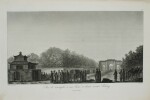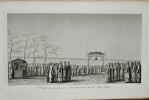5 books for « de guignes chretien ... »Edit
-
Topics
Costumes (2)
Customs (2)
Manila (2)
-
Countries
Belgium (3)
France (2)
[Eustache de Séve] - De GUIGNES , Chrétien Louis Joseph (1759-1845)
Reference : PHO-1697
(1808)
Voyages à Pékin, Manille et l'Île de France, faits dans l'intervalle des années 1784 à 1801, Atlas seul
Imprimerie Impériale, 1808, atlas seul, in folio, relié demi basane moderne, dos lisse avec auteur et titre, frottements, légères rousseurs, les 7 premières planches sont reliées en ordre contraire. L'atlas comporte 92 illustrations gravées sur 60 feuillets par De Guignes d'après Mérite et 6 cartes gravées (4 pliantes) par Houdan, dessin au lavis ajouté représentant une plante. Il semble être de Jacques Eustache de Sève qui a réalisé toutes les planches de l'atlas d'après les croquis de De Guignes. Il offre une parenté certaine avec les fig. de botanique 66, 67, 74 et 75.
Édition originale d'un récit estimé et bien illustré de la Chine et des Philippines par le sinologue et lexicographe français Chrétien-Louis-Joseph de Guignes. De Guignes a vécu en Chine pendant 17 ans, en partie comme résident de France en Chine et consul à Canton. Il fut attaché comme interprète à l'ambassade des Pays-Bas à Pékin (1794-1795), dirigée par Titsingh et Van Braam et fut le témoin de l’échec de l’ambassade anglaise de George Macartney Son récit de voyage raconte ses expériences en Chine, avec des illustrations d’après des croquis qu'il avait réalisés sur place. Il offre une perspective intéressante et personnelle sur l'ambassade à Pékin. De Guignes Chrétien Louis Joseph (1759-1845), était le fils de l'éminent sinologue Joseph Deguignes, et correspondant de l'Académie des Sciences et de l'Académie des Inscriptions et Belles-Lettres. Il est l'auteur d'un important dictionnaire, le "Dictionnaire Chinois-Français et Latin" (1813) commandé par Napoléon. Atlas in-folio, half calf modern, spine with title and auhor, with 92 engraved illustrations on 60 leaves by De Guignes after Deserve and 6 engraved maps (4 folding) by Houdan. First edition of an esteemed and well-illustrated account of China and the Philippines by the French sinologist and lexicographer Chrétien-Louis-Joseph de Guignes. De Guignes lived in China for 17 years, partly as Resident of France in China and consul at Canton. He was attached as interpreter to the Dutch embassy to Beijing (1794-1795), led by Titsingh and Van Braam. His engaging travelogue recounts his experiences in China, with illustrations after sketches that he made on the spot. De Guignes's narrative provides an interesting and personal perspective on the embassy to Beijing. - De Guignes was the son of the distinguished sinologist Joseph Deguignes, and a correspondent for the Académie des Sciences and the Académie des Inscriptions et Belles-Lettres. He authored an important dictionary, the "Dictionnaire Chinois-Français et Latin" (1813). M1-Et0 Cordier (Sinica) 2351f. Gay 3307.
Voyages à Péking, Manille et l'Île de France, faits dans l'intervalle des années 1784 à 1801
Imprimerie Impériale, 1808 , TEXTE et ATLAS ; Texte 3 volumes ,2ff-lxiij-439pp, 2ff-476pp, 2ff-488pp. relié demi cuir et coins , dos lisse avec pièces de titre et tomaison et un Atlas in-folio (400x270mm) , plein cuir époque , dos orné avec pièces de titre et tomaison rouge , frottements , début de fente, coiffe usée , gardes décollées ,petit travail de ver sur 10 feuillets sans atteinte ,intérieur très propre sans rousseurs ni piqûres , quelques rousseurs au texte. L'atlas comporte 92 illustrations gravées sur 61 feuillets par De Guignes d'après Mérite et 6 cartes gravées (4 pliantes) par Houdan.
Édition originale d'un récit estimé et bien illustré de la Chine et des Philippines par le sinologue et lexicographe français Chrétien-Louis-Joseph de Guignes. De Guignes a vécu en Chine pendant 17 ans, en partie comme résident de France en Chine et consul à Canton. Il fut attaché comme interprète à l'ambassade des Pays-Bas à Pékin (1794-1795), dirigée par Titsingh et Van Braam et fut le témoin de l’échec de l’ambassade anglaise de George Macartney Son récit de voyage raconte ses expériences en Chine, avec des illustrations d’après des croquis qu'il avait réalisés sur place. Il offre une perspective intéressante et personnelle sur l'ambassade à Pékin. De Guignes Chrétien Louis Joseph (1759-1845) ,était le fils de l'éminent sinologue Joseph Deguignes, et correspondant de l'Académie des Sciences et de l'Académie des Inscriptions et Belles-Lettres. Il est l'auteur d'un important dictionnaire, le "Dictionnaire Chinois-Français et Latin" (1813) commandé par Napoléon . Text 3 volumes 8° and 1 volume Atlas in-folio , full calf contempary ,spine with title and Atlas. The atlas with 92 engraved illustrations on 61 leaves by De Guignes after Deserve and 6 engraved maps (4 folding) by Houdan. First edition of an esteemed and well-illustrated account of China and the Philippines by the French sinologist and lexicographer Chrétien-Louis-Joseph de Guignes. De Guignes lived in China for 17 years, partly as Resident of France in China and consul at Canton. He was attached as interpreter to the Dutch embassy to Beijing (1794-1795), led by Titsingh and Van Braam. His engaging travelogue recounts his experiences in China, with illustrations after sketches that he made on the spot. De Guignes's narrative provides an interesting and personal perspective on the embassy to Beijing. - De Guignes was the son of the distinguished sinologist Joseph Deguignes , and a correspondent for the Académie des Sciences and the Académie des Inscriptions et Belles-Lettres. He authored an important dictionary, the "Dictionnaire Chinois-Français et Latin" (1813). A German translation of the "Voyages" appeared in Leipzig in 1809-1810. Cordier (Sinica) 2351f. Gay 3307.
GUIGNES Chretien Louis Joseph de ( 1759 - 1845 ) - Basilio BROLLO ( ) :
Reference : 39514
"Dictionnaire chinois , français et latin. Publié d'après l'ordre de sa majesté L'Empereur et Roi Napoléon le Grand ; par M. de Guignes...."
.: Paris, l'Imprimerie Impériale, 1813, large in-folio ( 47 x 30 cm ) , (6)nn pp + lvi pp + 1112 pp + (2)nn pp (errata). Complete but for the first blank leaf. Uncut copy. Bound in contemporary full vellum over strong boards, raised spine with red leather title label. Binding with some scratching and soiling, upper joint split over ca. 5 cm. Small paper restoration at the title page (where a name was cut out), no loss of text, tear repaired at the errata leaf, some minor stains or dustsoiling at some pages as usual but on the whole still a fine copy. Impressive large paper copy printed on strong laid paper. The chinese caracters are printed from woodcuts, most pages are divided in two colums. The monumental dictionary was published on orders given by Napoleon in 1809. It is the first large scale philological publication in a modern Western language to deal with Chinese and a such a milestone in the meeting of East and West. The editor de Guignes was one of the few Frenchmen at that time who had resided in China and this for over 17 years. The book is based on the work of the Italian missionary Basilio Brollo (1648 -1704) who compiled a Latin-Chinese dictionary (see John Lust , Western Books on China item 1038). De Guignes did not acknowledge this in his book but it was soon exposed after publication by e.g. Klaproth ( see J.Lust, idem, item 1037)..
GUIGNES Chretien Louis Joseph de ( 1759 - 1845 ) - Julius ( Jules ) KLAPROTH (1783 - 1835 ) - P. Basile de GLEMONA ( Basilio BROLLO ) - Adolf ELLISSEN ( provenance ) :
Reference : 46471
"Dictionnaire chinois , français et latin. Publié d'après l'ordre de sa majesté L'Empereur et Roi Napoléon le Grand ; par M. de Guignes....[Bound with] [2] Supplément au Dictionnaire Chinois- Latin ...publié d'après les ordres de sa Majesté Roi de Prusse Frédéric Guillaume III par Jules Klaproth."
".: [1] Paris, l'Imprimerie Impériale, 1813, large in-folio ( 47 x 30 cm ) , (6)nn pp + lvi pp + 1112 pp + (2)nn pp (errata). ( complete) [Bound with] [2] (Supplement) Paris, l'Imprimerie Royale, 1819, (12) pp + 168 pp ( complete). Bound in later buckram, the smooth old leather spine has been retained and tipped on to the new spine. A good sturdy binding. Both the dictionnary and his supplement are printed on strong laid paper. The chinese caracters are printed from woodcuts, most pages are divided in two colums. Provenance. This book once belonged to the German philologist Adolf Ellissen ( 1815 - 1872). His manuscript ex-libris ( in German and in Chinese caracters) is written on the title page of the dictionnary. Page X and (11,12-blank) of the supplement contain extensive notes written partially in Chinese and in 19th century cursive German handwriting. These neatly written notes are obviously transcriptions of classical Chinese texts with German translations and are most probably by the hand of Ellissen. The monumental dictionary was published on orders given by Napoleon in 1809. It is the first large scale philological publication in a modern Western language to deal with Chinese and as such a milestone in the meeting of East and West. The editor de Guignes was one of the few Frenchmen at that time who had resided in China and this for over 17 years. The book is based on the work of the Italian missionary Basilio Brollo (1648 -1704) who compiled a Latin-Chinese dictionary (see John Lust , Western Books on China item 1038 , and Lust 1048 for the supplement). De Guignes did not acknowledge this in his book but it was extensively exposed by Klaproth in the introduction to the Supplement which was published after the fall of Napoleon. It is rare to find the dictionary bound with the supplement; together with the fact that it belonged to the German philologist Ellissen of whom it is known that he dabbled in Chinese poetry ( and even published some translations - see Meyers Volksbücher nr. 618 ) makes this an interesting and desirable item."
Voyages à Peking, Manille et l'Ile de France. Faits dans l'intervalle des années 1784 à 1801 (complete in 4 volumes: 1 atlas and 3 text volumes ).
".: Paris, De L'Imprimerie Impériale, ( se trouve à Paris chez Treuttel et Würtz), 3 text volumes in-8° + 1 atlas in-folio. [1] (4)nn pp + LXIII pp + 439 pp ; [2] (4)nn pp + 476 pp ; [3] (4)nn pp + 488 pp. [4-atlas] (4)nn pp (title, table) + 98 engraved plates and maps, numbered 1-97 (plate n° 93 exists in a and b). Four n°s are large folding maps. (complete atlas and text volumes). Bound in uniform half leather, smooth spine with double leather labels , boards covered with marbled paper. Very fine and attractive copy; notwithstanding a slightly soiled title page of the first text volume and also in this volume a marginal stain at pages 2-8. Other volumes and atlas are near perfect. Fine and rare complete first edition of Guignes' report of his stay in Beijing and his travel to the Philippines. He lived for 17 years in China: as consul in Kanton, as interpreter at the Dutch embassy in Beijing ( under von Titsingh and Van Braam) . The illustrations show architecture and monuments, but also daily life and people. The maps are from Kanton, Macao, China, Philippines and Manilla. (see Cordier Sinica 2351 ; Cox I, 346 ; Lust 336 (no atlas).."
 Write to the booksellers
Write to the booksellers






